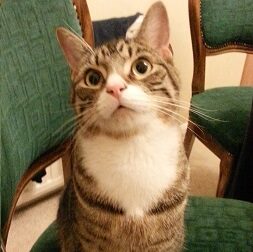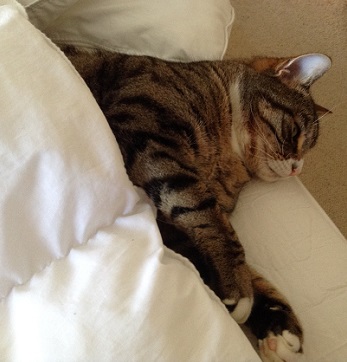We don’t know about your cats, but our cat Arnold is very vocal. He announces that he has come in, when he’s going out, just in case you might like to know! He definitely lets you know when he wants feeding. Or it might be that he just wants some fuss, like when he walks over my laptop when I’m trying to work, meowing loudly. Sound familiar with your cats?!

Well if you think your cat’s meows, chirps, yowls, and purrs are just random gibberish?
Think again.
They are actually communicating to you information about their world and about how they feel towards you. The good news is that if you listen closely, you just might begin to understand what the sounds your cat makes is all about and use that understanding to your advantage.
Next to birds, cats possess the widest range of vocalizations of any domestic pet. Though best known for their meows, purrs, hisses, and growls, the list of sounds they regularly make is more comprehensive than this. Depending on the situation, your cat is capable of making many distinct utterances, with multiple nuanced variations of each, according to importance. Some reflect contentment and ease, while others expose worry, fear, or even anger. All, though, are indicative of your cat’s emotional state of mind.
Meow
Perhaps the most commonly heard cat sound, the meow of an adult cat is almost exclusively used to communicate with humans, and not other cats. First uttered by kittens when in need of their mothers, this juvenile vocalization fades away as wild cats mature. But, as cats in domesticity tend to think of themselves as our eternal offspring, they maintain this endearing vocalization throughout their adult lives. Generally, a meowing cat wants something—attention or food or perhaps access to a room. Sometimes though, meows simply serve as a “welcome home” salutation.
Occasionally, a meow can signify loneliness or even illness. Older cats often meow more because of failing senses or due to anxiety over not being as nimble as before. In younger cats, the meow often gets shortened to an interrogative “mew?” when lonely or hungry. And the frequency of meowing is an indicator of a cat’s frame of mind; rapid-fire meows mean hey, pay attention to me, I’m talking here!
A longer, more plaintive “meowww” can indicate worry, annoyance, or objection to something. This version will often have a throatier quality to it, almost as if they are saying, “oh, come on.” And incessant meowing could indicate illness or injury; if you suspect this, consider a trip to the vet
Purr
Perhaps the most enjoyable and hypnotic of cat sounds, the purr is a soft, deep, throaty rumble, most often made when your cat is in the best of moods. Gently petting your cat while she nests in your lap is a sure way to bring forth this motoring sound of utter contentment. On rare occasions, purring can occur when your cat is agitated over something. It’s similar to how you might nervously whistle or hum while waiting for in-laws to arrive for dinner. The key to discerning this “worry-purr” is body posture; if your cat’s ears are back and her body seems tense, the purr denotes concern over something.
Chirps, Trills and Chirrups
Learned in kittenhood, these birdlike utterances are slightly more declarative than a meow. Originally used by mothers to tell kittens to pay attention and follow her, your cat may chirp in an effort to get you to pay attention to them or as a way to get you to check out something they deem important. Chirrups and squeaky little trills might also happen when a cat is excited and happy.
So people listen carefully and pay attention when your cat is talking to you. Who knows what they may be trying to tell you!

